History | 16.11.2009
The Russian Revolution – October 25, 1917
The thundering of a cannon from the armored tank "Aurora," gave the starting signal for the glorious October revolution. The vibrations were still ringing in the air as the soldiers of the Red Army boldly pushed their way into the Winter Palace in St. Petersburg – the seat of the government – sweeping aside defenders of the old system. That was the picture of the event painted later by Soviet propaganda. In reality, government members were sitting, scared and defenseless, inside the palace. They didn't put up much of a defense – they'd stood too long in the critique of both right-wing extremists and the Bolsheviks, or Communists.
Lenin and Trotsky
 Bildunterschrift: Großansicht des Bildes mit der Bildunterschrift: Vladimir Ilich Lenin
Bildunterschrift: Großansicht des Bildes mit der Bildunterschrift: Vladimir Ilich Lenin
Vladimir Lenin (1870–1924) and Leo Bronstein, known as Trotsky (1879–1940) were the figureheads of the insurgency. In October 1917, they led their followers into a revolution. Under Trotsky's command, the most important buildings in St. Petersburg (later, Leningrad) were occupied, and the members of the government arrested. A hastily gathered "All-Russian Congress of Soviets" approved the overthrow on the eve of the revolution, as well as the next steps of the new government: disappropriation of land owners and a truce with Germany.
The war of attrition on Russia's western front was to be ended immediately, so that Trotsky could begin negotiations with German military leaders immediately after the successful revolution.
Brest-Litovsk Treaty
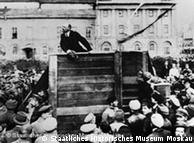 Bildunterschrift: Großansicht des Bildes mit der Bildunterschrift: Postcard with an original photo of Lenin and Trotsky in Moscow
Bildunterschrift: Großansicht des Bildes mit der Bildunterschrift: Postcard with an original photo of Lenin and Trotsky in Moscow
The Germans had approved of and supported the overthrow of the government in Russia. Now, they wanted to reach a convenient peace with Russia so that they could assemble their full military power on the western front against the French and British armies. But the negotiations proved difficult, and on November 17, 1917, all that had been agreed was a ceasefire. The actual peace negotiations began on December 9, 1917 near Warsaw – in Brest-Litovsk.
The fruitless negotiations were broken off at the end of January 1918. Trotsky would not accept the Germans' demand that they be permitted to annex large parts of territory occupied by the German army. As a consequence, fighting resumed. The German army progressed further, occupying ever more territory, with the result that a peace treaty was finally signed on March 3, 1918.
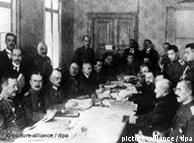 Bildunterschrift: Großansicht des Bildes mit der Bildunterschrift: Delegation at the Brest-Litovsk negotiations
Bildunterschrift: Großansicht des Bildes mit der Bildunterschrift: Delegation at the Brest-Litovsk negotiations
Ukraine and Finland received sovereignty, and Russia gave up its territorial claims to Poland and the Baltics. Armenia was promised to Turkey. This truce weakened Russia: 60 million citizens left the country, which was now some 1.4 million square kilometers smaller. The loss of bread basket Ukraine as well as that country's coal and iron industries were catastrophic to the Russian economy. The economic situation quickly proved to be a heavy price to pay for the Soviet government.
Stalin
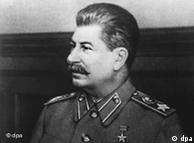 Bildunterschrift: Großansicht des Bildes mit der Bildunterschrift: Joseph Stalin
Bildunterschrift: Großansicht des Bildes mit der Bildunterschrift: Joseph Stalin
While Lenin and Trotsky, fueled with revolutionary fervor, pushed ahead with the overthrow, Joseph Vissarionovich Dzhugashvili – otherwise known as Stalin – was hesitant. As the Commissar of Nationalities, he had several objections to the revolution and took pains to distance himself from events related to the coup. After Lenin's death on Jan. 21, 1924, he was able to assume power within the party and the state. For almost 30 years, he was the leader of the Soviet Union. On the one hand, he successfully led his country throughout World War II, transforming Russia from an agricultural country into a world power. On the other hand, he was only able to achieve this via a regime of terror and suppression, and was responsible for the deaths of millions of people. According to the latest estimates, around 10 million farmers who were accused of being "capitalist peasants" (kulaks) exploiting the land were killed at Stalin's command during a campaign against them that lasted from 1928 to 1937.
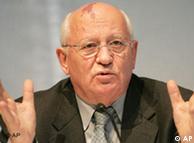 Bildunterschrift: Großansicht des Bildes mit der Bildunterschrift: Former Soviet Union President Mikhail Gorbachev
Bildunterschrift: Großansicht des Bildes mit der Bildunterschrift: Former Soviet Union President Mikhail Gorbachev
The USSR (Union of Soviet Socialist Republics) lasted until 1991. Michael Gorbachev's (1931) politics of reform – which became familiar to the world as "perestroika" and "glasnost" – were originally meant to only reform the Soviet state. However, Gorbachev's policies led to domestic difficulties and tough economic conditions which eventually consumed the whole of the USSR. In August 1991, the Baltic states declared their independence, and further members of the union followed their example. On December 8, 1991, the USSR was officially dissolved, and the remaining 12 member states joined together to form the Commonwealth of Independent States, or CIS.
Author: Matthias von Hellfeld (dc)
Editor: Andreas Illmer
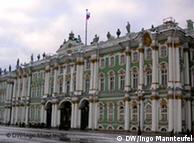
Comments